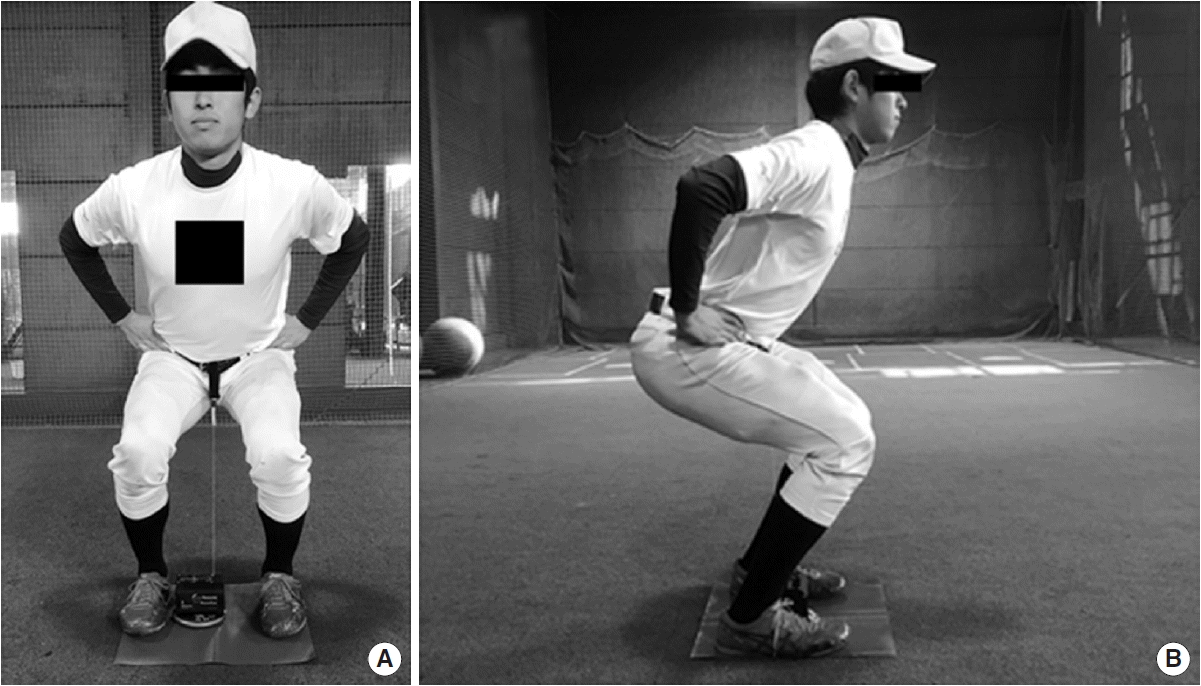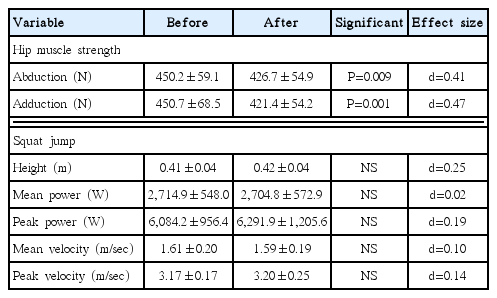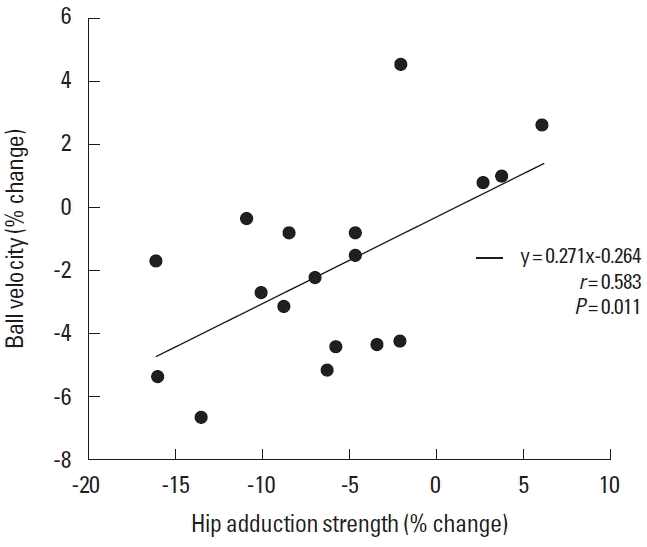Changes in lower extremity function and pitching performance with increasing numbers of pitches in baseball pitchers
Article information
Abstract
Compared to upper extremity function, the changes in lower extremity function with increasing numbers of pitches have not fully been investigated in baseball pitchers. In addition, little is known about the correlation between lower extremity function and pitching performance. The purpose of this study was to evaluate the effect of fatigue on lower extremity function and pitching performance in a simulated baseball game. Eighteen collegiate baseball pitchers threw 117 pitches in 9 innings (13 pitches per inning) with 5-min rest between innings at an official pitching distance in a simulated game. Isometric hip muscle strength (abduction and adduction) and squat jump performance (height, mean/peak power, and mean/peak velocity) were measured before and after the game. The mean ball velocity and pitching accuracy were assessed per inning. Ball velocity significantly decreased in the 7th (P=0.026) and 9th (P=0.001) innings compared to the 1st inning, but pitching accuracy did not change significantly. Hip abduction (P=0.009) and adduction (P=0.001) strength significantly decreased after the game, but squat jump performance did not significantly change before and after the game. A significant correlation between decreased ball velocity in the 9th inning and decreased hip adduction strength was found (P=0.011, r=0.583). Our findings suggest that hip abduction and adduction strength are susceptible to fatigue owing to repetitive throwing motions and that hip adduction strength, especially, is an important physical fitness factor for maintaining ball velocity during a game in baseball pitchers.
INTRODUCTION
Ball velocity and pitching accuracy are determining factors that strongly influence pitching performance for baseball pitchers. Several studies demonstrated a close correlation between ball velocity and ground-reaction force generated during pitching (Guido and Werner, 2012; MacWilliams et al., 1998). Therefore, greater force and power generated from the lower extremities is thought to be significant for increasing ball velocity in baseball pitching (Guido and Werner, 2012; Kageyama et al., 2014; Kageyama et al., 2015; MacWilliams et al., 1998). In addition, a stable base of the lower extremities should contribute to enhancement of pitching accuracy by supporting the powerful motions of the trunk and upper extremities (Fortenbaugh et al., 2009; Kageyama et al., 2014; Kageyama et al., 2015; Marsh et al., 2004; Milewski et al., 2012). Moreover, it is important for baseball pitchers to keep lower extremity function at a high level throughout the course of a baseball game for better pitching performance.
Several previous studies (Escamilla et al., 2007; Grantham et al., 2014; Murray et al., 2001) have investigated changes in biomechanical parameters of the lower extremities during pitching and ball velocity with increasing numbers of pitches in baseball pitchers. Murray et al. (2001) showed significant decreases in knee angle at ball release and ball velocity at the last inning of a simulated game in professional baseball pitchers. These findings might have resulted from muscle fatigue of the lower extremities due to repetitive pitching motions. Although Mullaney et al. (2005) found minimal muscle fatigue in the hip musculature after pitching 7±2 inning, pitching performance was not investigated in their study. To our knowledge, very few attempts have been made to quantify the changes in lower extremity function and pitching performance with increasing numbers of pitches in baseball pitchers. It is possible that lower extremity muscle fatigue diminishes energy transfer from the lower extremity to the trunk during baseball pitching, resulting in decreased ball velocity. Moreover, a fatigued lower extremity may adversely affect pitching accuracy.
The purpose of this study was to evaluate the effect of fatigue on lower extremity function and pitching performance in a simulated baseball game and to assess the correlation between lower extremity function and pitching performance. These data would be useful for constructing training, conditioning, and rehabilitation programs for baseball pitchers. Our hypothesis was that baseball pitchers would show significantly decreased lower extremity function and pitching performance in the game and that significant correlations would be found between lower extremity function and pitching performance.
MATERIALS AND METHODS
Participants
Eighteen overhanded collegiate male baseball pitchers (right-handed, n=12; left-handed, n=6; mean and standard deviation [SD]: age, 19.9±0.7 years; height, 177.8±4.8 cm; body mass, 75.9±4.9 kg) participated in this study immediately after the end of their spring baseball league games. All participants had no pain or discomfort in their body at the time of measurement and no previous history of extremity surgery or injury.
This study was approved by the institutional ethics committee of Jobu University (approval number: No.16-B01). Before the measurement, the purpose, potential risks, and examination procedures of this study were explained to all participants. Written informed consent was obtained from each participant, and the participants’ rights were fully protected.
Pitching protocol
We attempted to establish a pitching protocol similar to a single game situation as much as possible. After an adequate warm-up, each participant was asked to throw a baseball from a pitching mound to a catcher (the distance between a pitcher’s plate and a home plate was 18.44 m: official pitching distance) in all pitches. The participants were instructed to aim at the strike zone of a hand-made apparatus located in front of the home plate (Yanagisawa et al., 2018). The strike zone (length 60 cm×width 43 cm: width of home plate) of the apparatus corresponded to that of a batter approximately 175 cm tall. Participants threw 13 pitches (9 fastballs and 4 curveballs) per inning from a stretch position at a rate of one pitch every 15 sec; they were instructed to throw all fastball pitches at maximal effort (as fast as possible). Pitching was completed when the participants finished 9 innings of pitching with 5-min rest between innings. The total number of pitches was 117 pitches in 9 innings.
Pitching performance
Ball velocity of a fastball was measured using a radar gun (16JYM10000, MIZUNO Corp., Osaka, Japan) from behind the catcher. Mean ball velocity was evaluated per inning. In addition, pitching accuracy per inning was assessed as the passing rate of the strike zone in 9 fastball pitches (number of strikes/9 fastball pitches×100).
Hip abduction and adduction strength
Isometric muscle strength of hip abduction and adduction was measured using a dynamometer (T.K.K.3367b, Takei Scientific Instruments Co., Ltd., Niigata, Japan) with the participant in a seated position before and after the simulated game. The dynamometer was placed between the thighs. Then, fixation belts of the dynamometer were firmly worn around the distal end of each thigh (Fig. 1). The participant was instructed to maximally perform 5-sec isometric hip adduction by pushing the pads of the dynamometer or abduction by pulling the fixation belts of the dynamometer. The calibration of the dynamometer was always performed prior to each trial. The participant performed two trials in the measurements of hip abduction or adduction strength. The maximum value of the two trials was used for analysis. The participants were always given verbal encouragement during force generation.
Squat jump
The height, mean/peak power, and mean/peak velocity for squat jump without arm swing were measured using a digital optical encoder (Gymaware, Kinetic Performance Technology, Canberra, Australia) before and after the simulated game. The optical encoder was positioned on the ground perpendicular to the movement of the body. The connection cable coupled to the encoder was attached via a tether to the belt of the participant; jump height was set to 0 m at upright standing position. Then, the participants performed the squat jump with their knee flexed at 90°, with their hands on the hips, and with the stance at hip width (Fig. 2). The examiners checked the knee angle with a goniometer before the jump and no reaction movement at the start of the jump. Participants were asked to hold the squat position for 3 sec before performing a maximal vertical jump. Additionally, they were instructed to jump as high and fast as possible. Data (jumping height, mean/peak power, and mean/peak velocity) regarding the maximal jump height of 2 trials was used for subsequent analysis.
Statistical analysis
The mean and SD were calculated for all variables. Data regarding hip strength and squat jump were compared before and after the simulated game by using a paired t-test. One-way analysis of variance with a Dunnett test was used to detect significant changes from 1st inning in mean ball velocity and pitching accuracy. In addition, effect sizes (Cohen d) (Cohen, 1992) were calculated and evaluated as trivial (0–0.19), small (0.20–0.49), medium (0.50–0.79), and large (0.80 and greater). Moreover, Pearson’s correlation coefficients (r) were used to evaluate the correlations between lower extremity function after the simulated game and pitching performance in the 9th inning; the rate of change in each variable was calculated. Statistical significance was set at P<0.05 for all analyses.
RESULTS
Pitching performance
Fig. 3 shows the changes of ball velocity from the 1st to 9th inning. Ball velocity significantly decreased in the 7th (128.4±5.7 km/hr, P=0.026, d=0.32) and 9th (127.8±6.8 km/hr, P=0.001, d=0.38) innings compared to the 1st inning (130.3±6.2 km/hr). On the other hand, pitching accuracy did not show significant change from the 1st inning (1st inning, 53.1%±21.1%; 2nd inning, 46.9%±24.3%; 3rd inning, 48.1%±18.7%; 4th inning, 45.1%±16.4%; 5th inning, 48.8%±23.8%; 6th inning, 43.2%± 18.2%; 7th inning, 45.7%±17.8%; 8th inning, 56.2%±21.4%; 9th inning, 44.4%±17.0%).
Hip muscle strength and squat jump
Table 1 displays the values of hip muscle strength and squat jump. Hip abduction (P=0.009, d=0.41) and adduction (P=0.001, d=0.47) strength significantly decreased after the simulated game. On the other hand, the height, mean/peak power, and mean/peak velocity for squat jump without arm swing showed no significant changes before and after the simulated game.
Correlations between lower extremity function and pitching performance
The simulated game resulted in significantly decreased hip abduction and adduction strength and ball velocity. A significant correlation was found between decreased ball velocity in the 9th inning and decreased hip adduction strength immediately after the game (P=0.011, r=0.583) (Fig. 4).
DISCUSSION
In the present study, hip abduction and adduction strength significantly decreased after the simulated game. These findings would be attributed to muscle fatigue resulting from repetitive throwing motions. In baseball pitching, stride length is an important biomechanical parameter for generating greater translational energy using the downward slope of the pitching mound (Dillman et al., 1993; Fortenbaugh et al., 2009; Fry et al., 2017; Milewski et al., 2012). Hip abduction strength in the pivot leg helps stabilize the pelvis and lengthen the stride by preventing downward tilt of the contralateral pelvis during the wind-up and early cocking phases of baseball pitching (Kageyama et al., 2014; Laudner et al., 2010). After stride foot contact, the stride leg generates a braking force to decelerate the motions of the lower extremities and serves as an anchor in transforming the forward and vertical momentum into rotational components (MacWilliams et al., 1998). Kageyama et al. (2014) demonstrated that hip adduction torque on the stride leg at stride foot contact was significantly greater in high-ball-velocity pitchers than in low-ball-velocity pitchers, and suggested that the greater hip adduction torque contributes to the control/stabilization of the stride leg to increase the rotation and forward motion of the trunk after the late cocking phase of baseball pitching as well as the production of greater ground-reaction force on the stride leg, resulting in the generation of high ball velocity. Similarly, the hip abductors in the stride leg also possibly contribute to the control/stabilization of the stride leg after stride foot contact (Guido and Werner, 2012; Kageyama et al., 2014; MacWilliams et al., 1998; Milewski et al., 2012). Taken together, hip abductors and adductors are thought to play important roles in the gain of appropriate stride length as well as the smooth energy transfer from the stride leg to the trunk (as a part of the entire kinetic chain) during pitching. Our findings suggest that hip adduction strength is an important physical fitness factor for baseball pitchers to maintain the ball velocity during a game. On the other hand, although Mullaney et al. (2005) found minimal muscle fatigue in the hip musculature after pitching 7±2 inning (99±29 pitches per game), the change was not significant. Therefore, further accumulation of data is needed to clarify the effect of repetitive throwing motions on hip muscle strength in baseball pitchers.
Contrary to our expectation, in the present study all variables of the squat jump did not show significant decreases after the simulated game. Previous studies (Kageyama et al., 2014; MacWilliams et al., 1998) indicated that ball velocity correlates highly with the maximal push-off force (greater momentum by hip and knee extension) of the pivot leg generated during pitching, which supplies the initial forward momentum of the entire body in the direction of the pitch. Lehman et al. (2013) revealed that high ball velocity significantly correlated with the test score in a unilateral side jump in the frontal plane, which mimics the stride action of baseball pitching. Moreover, Murray et al. (2001) suggested that lower extremity muscle fatigue caused significant decreases in knee angle at ball release and ball velocity at the last inning of a simulated game in professional baseball pitchers. Taken together, extension power (force) of the lower extremities is thought to be a physical fitness factor that is related to ball velocity in baseball pitchers. However, the effect of repetitive throwing motions on jump performance was not found in the present study.
The present study has a few limitations. First, the lack of remarkable change in the present study may partly be attributed to limitations due to pitching in a simulated game (a noncompetitive environment) because a simulated game cannot completely replicate the conditions experimented during a competitive game (Escamilla et al., 2007). It is possible that baseball pitchers feel more physical and/or mental fatigue in an actual game than a simulated game, resulting in more decreased muscle function and pitching performance. Second, we measured hip muscle strength and jump performance only before and after the simulated game because we thought that the number of measurements should be limited to properly assess acute physical responses (fatigue) immediately after pitching. To date, very few studies have attempted to investigate the effects of repetitive throwing motions on lower extremity function in baseball pitchers. Thus, further research is required to clarify changes in various lower extremity functions with increasing numbers of pitches in baseball pitchers at various competitive levels. In particular, physically immature baseball pitchers may be susceptible to lower extremity muscle fatigue with increasing numbers of pitches (Erickson et al., 2016). Additionally, it was revealed that lower extremity power (vertical jump height and power) decreases with age in professional baseball pitchers (Mangine et al., 2013). Third, although we did not measure upper extremity and trunk functions in this study, it is possible that muscle fatigue of the upper extremity and/or trunk muscles was related to decreased ball velocity at the end of the simulated game.
In conclusion, our data showed that hip abductors and adductors of baseball pitchers are susceptible to muscle fatigue due to repetitive throwing motions. In addition, hip adduction strength is thought to be an important physical fitness factor for maintaining ball velocity during a game in baseball pitchers.
Notes
CONFLICT OF INTEREST
No potential conflict of interest relevant to this article was reported.
ACKNOWLEDGMENTS
This study was supported by a Grant-in-Aid for Scientific Research (C) from Japan Society for the Promotion of Science. The results of the current study do not constitute endorsement of the product by the authors or the journal.





